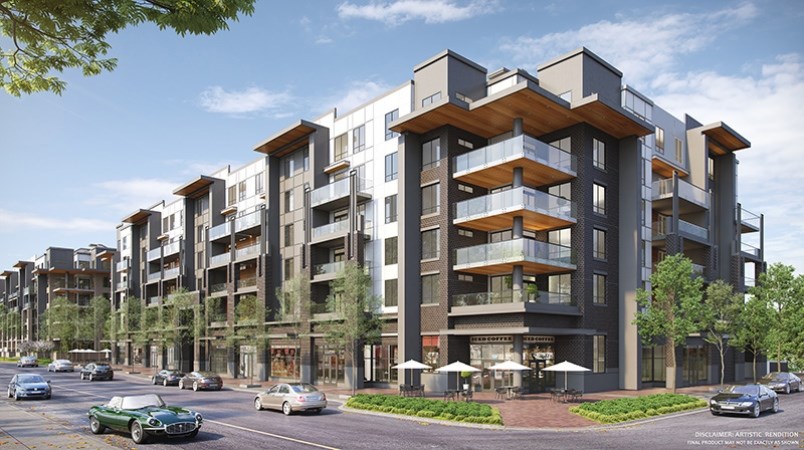If (like this writer) you’re sweltering at home in the summer heat, chances are that you’re in an older building that was constructed when developers didn’t even think about adding central air-conditioning.
Going back 30, 20, even 10 years ago, summer temperatures didn’t often get to extremes – and when they did, the occurrences were rare enough that installing central air-con wasn’t worth the time or cost. But look at any heat map or temperature graph for Canada (and indeed, the rest of the globe), and you’ll see a dramatic rise in mercury levels in recent years.
“We’ve all noticed the climate change – in the last five to seven years, the weather has more peaks in terms of hotter summers and colder winters,” said Kush Panatch, principal of development company Panatch Group, formerly Centro Development.
The company is building condo project 50 Electronic Avenue in Port Moody, which will have air-conditioning throughout. Panatch said his customers are beginning to expect this feature more and more – starting from when the company built the Terra West condo building in Richmond around five years ago.
But he added that a bigger variation in local temperature peaks and troughs was not the only reason for customer demand for forced-air heating and cooling.
“In the Richmond project, a lot of our buyers were Asian, and coming from a hotter climate they were accustomed to having air-conditioning. The buyers were looking for air-conditioning and finding that not every building in Richmond had it, and as a result we picked up buyers.”
Panatch added, “At the time, we were also looking to differentiate from other projects in Richmond, and give it more of a luxury feel. That’s why we did it the first time. Then in our OneWest townhouse project in Richmond, a year ago, we found that older buyers liked the climate control when downsizing from single-family homes.”
Falling costs of incorporating cooling
Jason Turcotte, vice-president of development at Cressey Development Group, concurs that it’s not just the rising mercury that has led his company to include air-conditioning as standard in all new projects over the past five years. But Cressey also has other reasons, in addition to demand from overseas buyers, for including this feature in their homes.
“One reason is a change in policy in the engineering department of municipalities. We’ve seen the development of neighbourhood energy utilities, which are essentially small, localized plants that serve to heat spaces. And buildings are required to use it as a source of heat, which pushes the design of buildings away from traditional baseboard heating and into more complicated heating systems. So when you get into those systems, it became a far less expensive venture to incorporate cooling into the building.
He added, "Of course, we were at the same time seeing longer, hotter summers, which helped to rationalize it. But really, the incremental costs to go to cooling systems became much more palatable.”
Another factor that drastically brought down the relative cost to the developer of incorporating cooling systems was the overheating of the real estate market, Turcotte explained.
“As a percentage of the unit cost, it became even further justifiable because of skyrocketing real estate prices,” he said. “So, it seems like a response to the weather, but I think it’s more a response to other factors. There’s also the element of ‘keeping up with the Joneses’ where other developers are including air-conditioning and it’s been well-received. So where it was unusual to see air-conditioning 15 years ago, it’s unusual not to see it today.”
Rising costs to the homeowner
So the developers may be able to absorb those costs, but what about the buyer?
Turcotte acknowledged that the cost of a unit in an air-conditioned building would likely be around $25,000-$30,000 more than in a baseboard-heated standard building – although, he added, “you’re aren’t able to start at that baseline [as all new buildings are including air-con].” However, Panatch conceded, forced-air cooling and heating is also a higher daily operating costs to the homeowner than baseboard heating.
Cressey is working on two new condo buildings, both of which have very different systems but both offering units that are climate-controlled by the buyer. At Chelsea, a condo project at 31st and Cambie, which has a heat-pump system with a compressor inside the units, where owners have control over their heating and cooling. In the Bellevue building in West Vancouver, which has large suites marketed at wealthy downsizers, the company has gone with a multi-zoned fan-coil system, which allows for different zones within suites, also controllable by the owner and privately metered for each unit. “It’s two different ways of doing it, both giving you that same end result,” Turcotte added.
The new normal
Real estate marketing firm MLA Canada has also recently launched developments of varying size that have air-conditioning, including luxury high-rise The Smithe by Boffo in downtown Vancouver, Coromandel Properties’ eight-storey building Winston on South Oak, and Hensley by Cressey, a 33-storey tower in West Coquitlam.
Cameron McNeill, MLA’s executive director, agrees that central cooling is the new normal for new residential buildings – especially in pricier markets.
“Over the last few years, we are seeing a majority of high rises and luxury condos include air-conditioning. It will also vary by market but it is becoming a standard for presale developments in Vancouver’s West Side,” he said. “Our local homebuyers are well researched, and air-conditioning that cools the home during the warmer season offers comfort – while also providing a great value-add for developers marketing their new project.”




